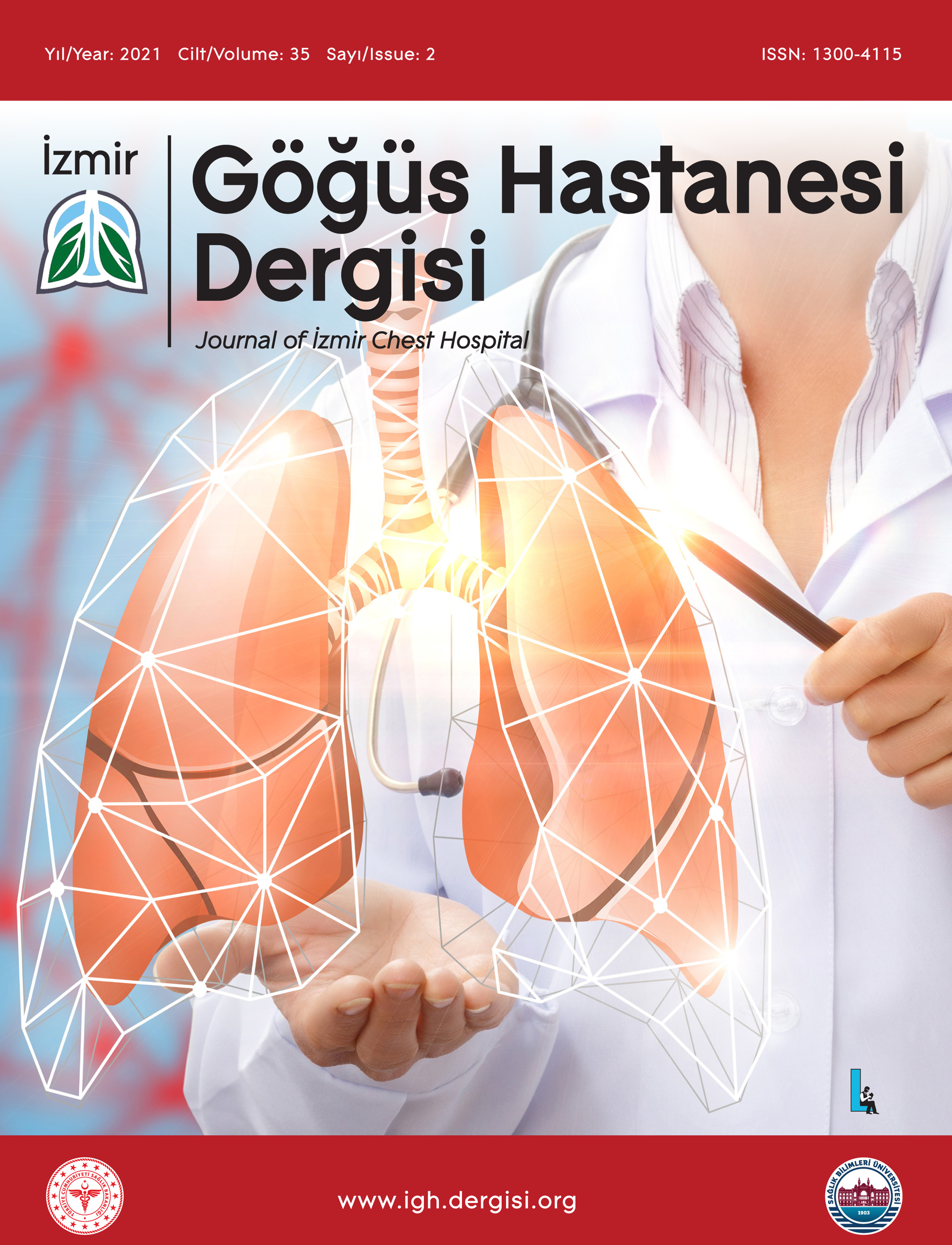İNTERSTİYEL AKCİĞER HASTALIĞINDA YOĞUN BAKIM ÜNİTESİNDE MEKANİK VENTİLASYON
Fatma ÇİFTCİ1, Ahmet Onur DAŞTAN1, Serhat EROL1, Aydın ÇİLEDAĞ1, Akın KAYA1Ankara Üniversitesi Tıp Fakültesi, Göğüs Hastalıkları, Ankara, TürkiyeAmaç: İnterstisyel akciğer hastalığı (İAH) olan ve akut solunum yetersizliği nedeniyle yoğun bakım ünitesinde (YBÜ) tedavi edilen hastaların prognozu hakkında veriler kısıtlıdır. YBÜ nde mekanik ventilatör ile solunum destek tedavisi alan İAH olgularının özellikleri ve mortaliteyi etkileyen risk faktörleri değerlendirildi. Yöntem ve Gereç: Tek merkezli, prospektif araştırmaya Ocak 2013- Ağustos 2017 tarihleri arasında 65 hasta (29 K, 36 E) dahil edildi. Olguların YBÜ ne alındıklarındaki klinik bulguları, takiplerinde ventilasyon destek tedavilerinin (NIV, IMV) mortalite üzerindeki etkileri incelendi. Bulgular: Tanıları 34 hastada IPF, 13 kollajen doku hastalığı, 10 akut interstisyel pnömoni, 3 Wegener granulomatozu, 2 sarkoidoz, 1 kronik hipersensitivite pnömonisi, 1 ilaca bağlı akciğer hastalığı, 1 hastada plöroparankimal fibroelastozis bulundu. 43 (%66,1) hasta YBÜ nde ex oldu. YBÜ takibi sonunda yaşayan ve yaşamayan hasta grupları karşılaştırıldığında PaO2/FiO2 oranı ve GKS yaşayan grupta anlamlı yüksek bulundu. Tek değişkenli Cox regresyon analizinde GKS (HR 1,225; 95% CI: [0,783-1,550]; p=0,052), APACHE II (HR 2,845; 95% CI: [1,431-3,751]; p=0,006), PaO2/FiO2 (HR 1,753; 95% CI: [1,169-1,932]; p=0,012), sPAP (HR 1,601; 95% CI: [0,263-1,710]; p=0,031), ve IMV ihtiyacının (HR 8,441; 95% CI: [3,225-12,632]; p<0,001) YBÜ nde mortalite riskini arttırdığı görüldü. Çok değişkenli analiz sonuçlarına göre PaO2/FiO2 (HR 1,224; 95% CI: [0,832-1,705]; p=0,015), APACHE II (HR 1,956; 95% CI: [1,031-4,216]; p=0,010), ve IMV ihtiyacı (HR 7,473; 95% CI: [3,028-9,243]; p<0,001) mortalitenin bağımsız risk faktörleriydi. Sonuç: İAH bağlı akut solunum yetersizliği nedeniyle YBÜ ne alınan hastalarda mortalite yüksektir ve PaO2/FiO2, APACHE II ve IMV ihtiyacı mortalitenin en önemli risk faktörleridir.
Anahtar Kelimeler: İnterstisyel akciğer hastalığı, akut solunum yetersizliği, non-invaziv ventilasyon, invaziv mekanik ventilasyonMECHANICAL VENTILATION OF PATIENTS WITH INTERSTITIAL LUNG DISEASE IN ICU
Fatma ÇİFTCİ1, Ahmet Onur DAŞTAN1, Serhat EROL1, Aydın ÇİLEDAĞ1, Akın KAYA1Ankara Üniversitesi Tıp Fakültesi, Göğüs Hastalıkları, Ankara, TürkiyeAim: A limited number of studies have investigated the prognosis of patients with interstitial lung disease (ILD) who are treated for acute respiratory failure in the intensive care unit. This study aimed to evaluate the outcome of patients with ILD in ICU. Material and Methods: A total of 65 patients with ILD (29 females, 36 males) were enrolled in this single-center study between January 2013 and August 2017. Survivor and non-survivor groups were compared according to characteristics and treatment needs (NIV and IMV) during their follow up in the ICU. Baseline characteristics and effects of ventilatory supports (NIV,IMV) on mortality were evaluated. Results: The type of ILD was IPF in 34 patients, collagen tissue disease in 13, interstitial pneumonia in 10, Wegener granulomatosis in 3, sarcoidosis in 2, chronic hypersensitivity pneumonitis in 1, druginduced ILD in 1 and pleuroparenchymal fibroelastosis in 1. Forty-three (66.1%) patients died during their treatment in the ICU setting and were grouped as non-survivors. PaO2/FiO2 rate and GCS .were lower and APACHE II score was higher in the non-survivor group than the survivor group. A univariate cox regression analysis revealed that GCS (HR 1.225; 95% CI: [0.783-1.550]; p=0.042), APACHE II (HR 2.845; 95% CI: [1.431-3.751]; p=0.006), PaO2/FiO2 (HR 1.753; 95% CI: [1.169- 1.932]; p=0.012), sPAP (HR 1.601; 95% CI: [0.263- 1.710]; p=0.031), and IMV need (HR 8.441; 95% CI: [3.225-12.632]; p<0.001) were significantly correlated to mortality in the ICU. A multivariate analysis showed that PaO2/FiO2 (HR 1.224; 95% CI: [0.832-1.705]; p=0.015),, APACHE II (HR 1.956; 95% CI: [1.031-4.216]; p=0.010), and IMV need (HR 7.473; 95% CI: [3.028-9.243]; p<0.001) were the significant independent predictors of mortality. Conclusion: PaO2/FiO2, APACHE II, and IMV need are the most important risk factors for mortality among patients with ILD and ARF who are admitted to ICU.
Keywords: Interstitial lung disease, acute respiratory failure, non-invasive ventilation, invasive mechanical ventilationMakale Dili: Türkçe






